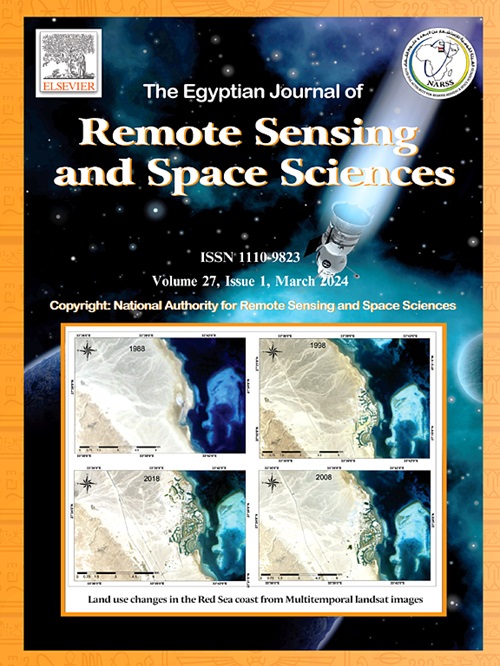Climate impact on spatial patterns of Aedes aegypti abundance in Al-Quseer with distribution maps
IF 4.1
3区 地球科学
Q2 ENVIRONMENTAL SCIENCES
Egyptian Journal of Remote Sensing and Space Sciences
Pub Date : 2025-09-16
DOI:10.1016/j.ejrs.2025.09.002
引用次数: 0
Abstract
The invasion of new mosquito disease vectors can alter the abundance of resident mosquito populations, leading to new vector distribution patterns and associated disease risks. A notable example is the re-invasion of the Red Sea region by Aedes aegypti since 2017, facilitated by the area’s hot and humid conditions. In this study, Ae. aegypti larvae were collected from indoors and outdoors habitats and entomological indices were calculated. To assess the influence of climate on spatial distribution, we utilized Landsat-8 satellite-derived maps of Al Quseer (Red Sea Governorate, Egypt), incorporating key climatic and environmental abiotic factors to develop a cartographic model. This model classified areas into different risk levels for Aedes breeding and prevalence. Our results indicate that the primary climatic and environmental factors affecting Ae. aegypti distribution and abundance were temperature, moisture, and vegetation cover—the latter of which indirectly influences microclimates by providing shade and maintaining humidity, thereby affecting mosquito resting sites and survival. The study identified three major risk levels based on breeding suitability: high-risk areas (0.15 km2), moderate-risk areas (0.47 km2), and limited-risk areas (7.24 km2). Of the total study area (4,659 km2), mosquito activity was detected across 655.62 km2, while 4,003.78 km2 remained unaffected. Urban areas within high-risk zones covered 9.11 km2, whereas only 0.25 km2 of urban districts in Al Quseer fell outside the mosquito’s range. Understanding the ecological drivers of Ae. aegypti abundance and predicting its future distribution provides critical insights into vector biology and potential expansion, offering valuable guidance for integrated dengue control strategies.
气候对Al-Quseer地区埃及伊蚊丰度空间格局的影响及分布图
新的蚊子病媒的入侵可以改变蚊子种群的丰富程度,导致新的病媒分布模式和相关的疾病风险。一个值得注意的例子是,自2017年以来,埃及伊蚊(Aedes aegypti)在红海地区炎热潮湿的条件下再次入侵。在这项研究中,Ae。在室内和室外生境采集埃及伊蚊幼虫,计算昆虫学指数。为了评估气候对空间分布的影响,我们利用Landsat-8卫星衍生的Al Quseer(红海省,埃及)地图,结合关键的气候和环境非生物因子建立了制图模型。该模型将伊蚊孳生和流行的风险等级划分为不同的地区。研究结果表明,主要的气候和环境因素影响了白蛉的生长。埃及伊蚊的分布和数量取决于温度、湿度和植被覆盖——后者通过提供荫凉和保持湿度间接影响小气候,从而影响蚊子的休息地点和生存。该研究根据育种适宜性确定了3个主要风险等级:高风险区(0.15 km2)、中等风险区(0.47 km2)和有限风险区(7.24 km2)。在总研究面积(4659 km2)中,655.62 km2有蚊虫活动,4003.78 km2未受影响。高风险区的城市面积为9.11平方公里,而Al Quseer的城市地区只有0.25平方公里不在蚊子的活动范围内。了解Ae的生态驱动因素。埃及伊蚊的丰度和对其未来分布的预测为了解媒介生物学和潜在的扩展提供了重要的见解,为登革热综合控制战略提供了有价值的指导。
本文章由计算机程序翻译,如有差异,请以英文原文为准。
求助全文
约1分钟内获得全文
求助全文
来源期刊
CiteScore
8.10
自引率
0.00%
发文量
85
审稿时长
48 weeks
期刊介绍:
The Egyptian Journal of Remote Sensing and Space Sciences (EJRS) encompasses a comprehensive range of topics within Remote Sensing, Geographic Information Systems (GIS), planetary geology, and space technology development, including theories, applications, and modeling. EJRS aims to disseminate high-quality, peer-reviewed research focusing on the advancement of remote sensing and GIS technologies and their practical applications for effective planning, sustainable development, and environmental resource conservation. The journal particularly welcomes innovative papers with broad scientific appeal.

 求助内容:
求助内容: 应助结果提醒方式:
应助结果提醒方式:


